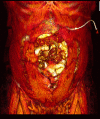Preoperative Progressive Pneumoperitoneum Revisited
- PMID: 34733881
- PMCID: PMC8559773
- DOI: 10.3389/fsurg.2021.754543
Preoperative Progressive Pneumoperitoneum Revisited
Abstract
Incisional hernia represents a common and potentially serious complication of open abdominal surgery, with up to 20% of all patients undergoing laparotomy subsequently developing an incisional hernia. This incidence increases to as much as 35% for laparotomies performed in high-risk patients and emergency procedures. A rarely used technique for enabling closure of large ventral hernias with loss of domain is preoperative progressive pneumoperitoneum (PPP), which uses intermittent insufflation to gradually stretch the contracted abdominal wall muscles, increasing the capacity of the abdominal cavity and allowing viscera to re-establish right of domain. This assists in tension-free closure of giant hernias which may otherwise be considered inoperable. This technique may be used on its own, or in conjunction with preoperative Botulinum Toxin A to confer paralysis to the lateral oblique muscles. These two complementary techniques, are changing the way complex hernias are managed.
Keywords: Botulinum Toxin A; complex hernia; incisional hernia; loss of domain; preoperative progressive pneumoperitoneum.
Copyright © 2021 Elstner, Moollan, Chen, Jacombs, Rodriguez-Acevedo, Ibrahim, Ho-Shon, Magnussen and Read.
Conflict of interest statement
The authors declare that the research was conducted in the absence of any commercial or financial relationships that could be construed as a potential conflict of interest.
Figures



References
LinkOut - more resources
Full Text Sources

